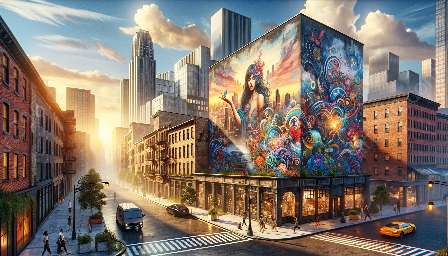Street art serves as a potent form of visual expression, often embodying cultural, social, and political commentary. However, the creation, preservation, and accessibility of street art are affected by numerous social and economic barriers that impact its role in community building.
Socioeconomic Factors and Accessibility
One of the key social barriers in street art is the socioeconomic disparity that affects both the artists and the audience. Many street artists may face financial constraints, limiting their ability to dedicate time and resources to their craft. This can result in a lack of diversity in the street art scene, with individuals from privileged backgrounds having greater opportunities to pursue and showcase their work.
Moreover, the accessibility of street art is often uneven across different communities. Areas with lower socioeconomic status may have limited resources or infrastructure to support street art initiatives, leading to a lack of representation and visibility for these communities in the urban art landscape.
Legal and Regulatory Challenges
Another significant barrier pertains to the legal and regulatory challenges that street artists encounter. Many cities have strict regulations governing public art, often leading to the removal or destruction of unauthorized pieces. This not only undermines the artistic freedom of street artists but also restricts the ability of communities to engage with and benefit from the creative expression present in their environment.
The legal barriers also pose challenges in terms of property rights and ownership, particularly when street art is situated on private property. Disputes over intellectual property rights and unauthorized use of space can hinder the sustainable growth of street art within a community.
Economic Viability and Sustainability
The economic viability of street art is a critical consideration that impacts its longevity and impact on community building. Street artists often face financial constraints in procuring quality materials, obtaining necessary permits, and accessing suitable spaces for their work. This economic burden can limit the potential for street art to thrive as a sustainable and contributory force in urban rejuvenation.
Moreover, the lack of formal support and funding mechanisms for street art initiatives can impede community building efforts. Without adequate investment and financial backing, street art may struggle to fulfill its potential as a catalyst for social cohesion and cultural enrichment.
Community Building and Empowerment
Despite these barriers, street art continues to play a pivotal role in community building, offering a platform for inclusive dialogue and creative expression. By breaking down social barriers and transcending economic constraints, street art has the power to unite diverse communities and foster a sense of belonging and empowerment.
Communities that embrace street art can experience the revitalization of public spaces, the amplification of marginalized voices, and the celebration of local heritage. Street art can be a vehicle for community-led initiatives, inspiring collaboration and solidarity among residents and artists alike.
Conclusion
In conclusion, the impact of social and economic barriers in street art is multifaceted, influencing the accessibility, sustainability, and community-building potential of this art form. Understanding and addressing these barriers is essential for creating a more inclusive and equitable environment for street art to flourish, enriching urban landscapes and fostering meaningful connections within communities.
By recognizing the challenges and advocating for supportive policies and initiatives, we can harness the transformative power of street art to bridge social divides and inspire positive change.

